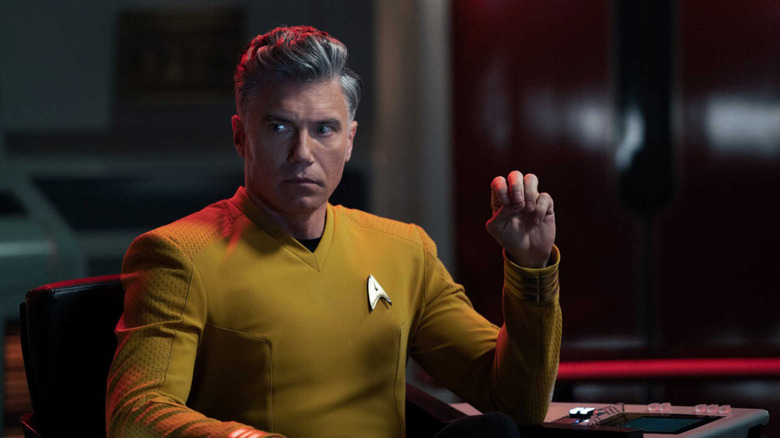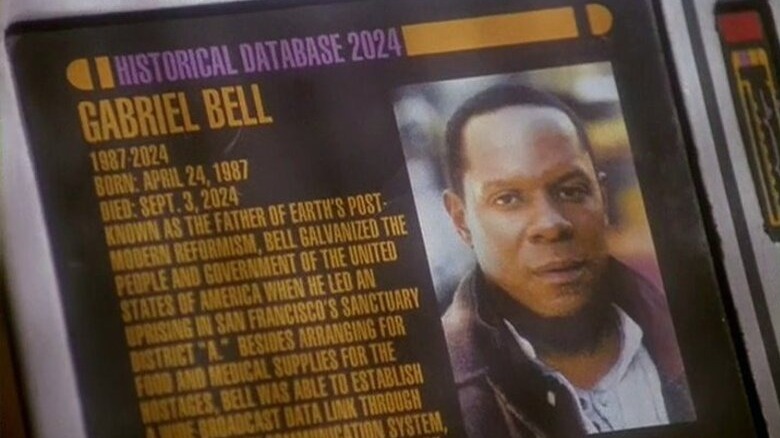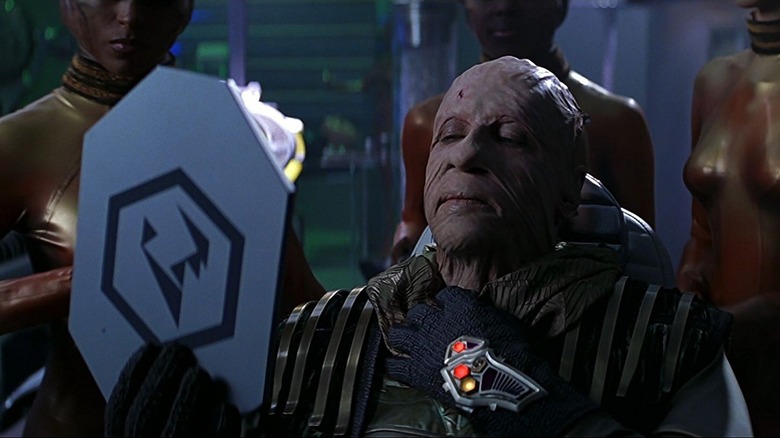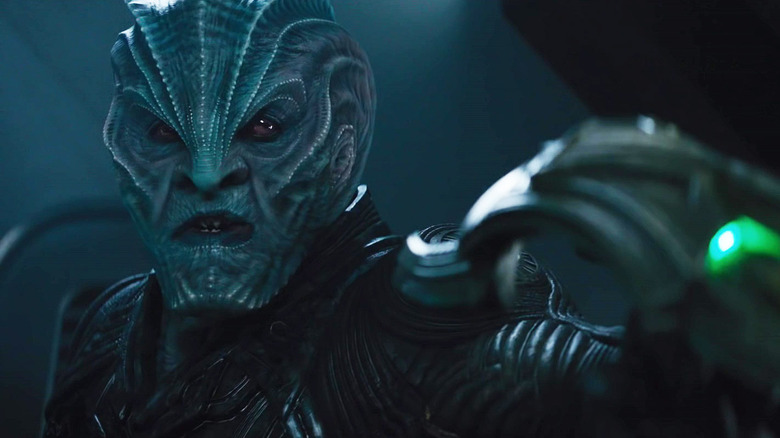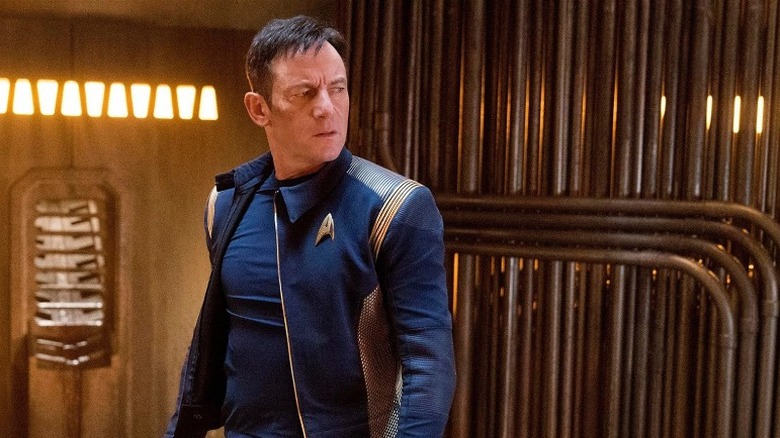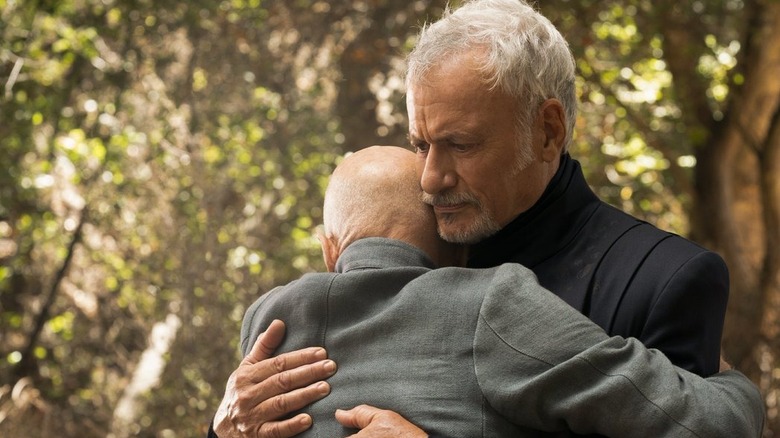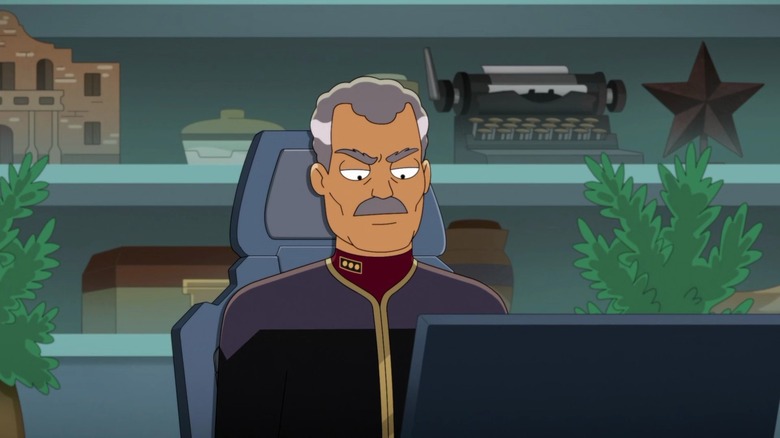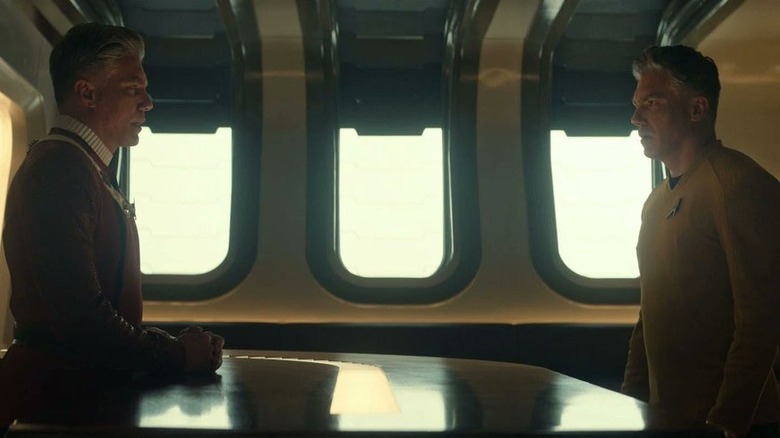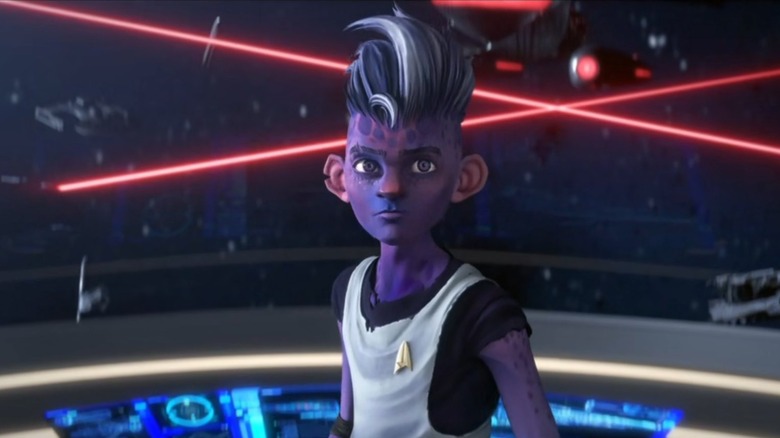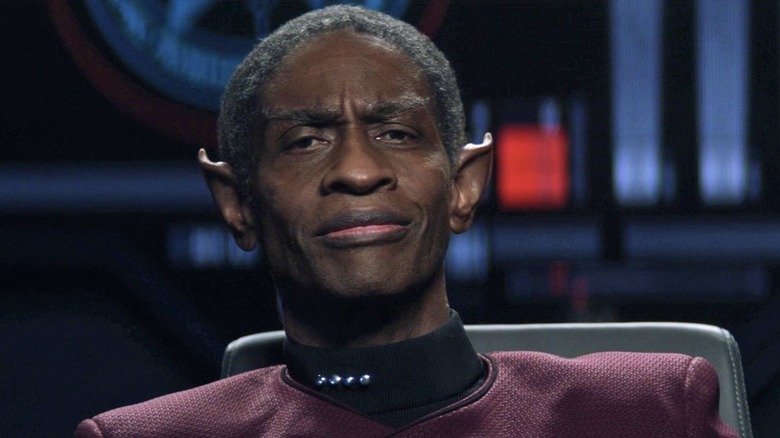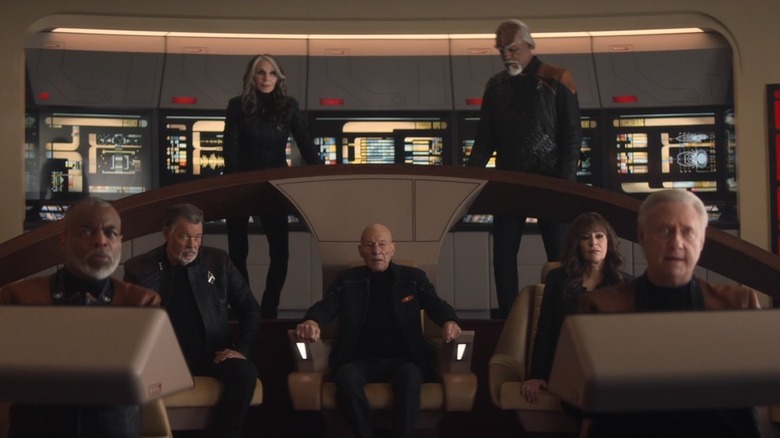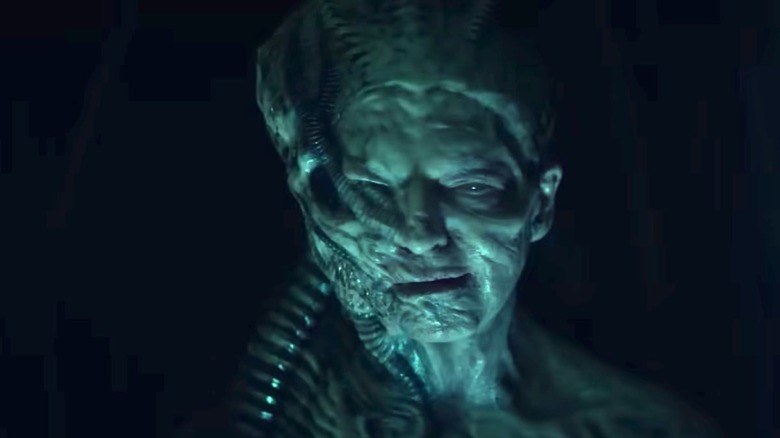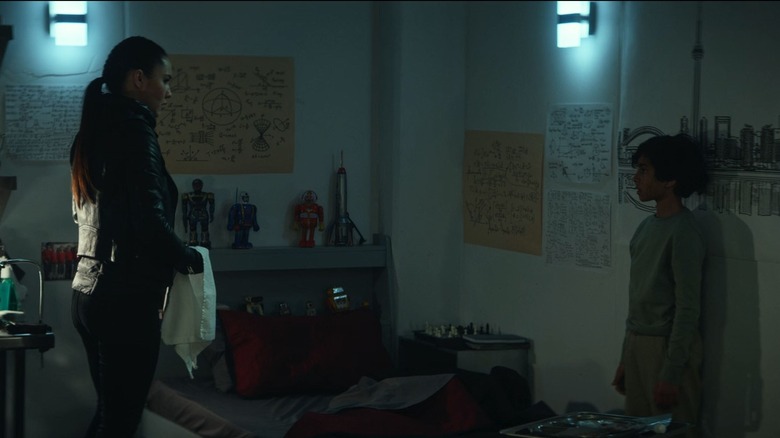12 Biggest Plot Twists In Star Trek We Never Saw Coming
With over a dozen feature films and a growing line of television series, "Star Trek" remains one of the most enduring and beloved science properties of all time. While pushing the boundaries of what's possible within the sci-fi genre, the franchise has always featured plenty of plot twists to keep audiences on their toes. From journeys through time yielding surprises tied to humanity's history to the return of classic villains, there are plenty of effectively shocking moments in "Star Trek."
Here are the biggest and most memorable twists across the entire "Star Trek" franchise, in both film and television, that we never saw coming. Like any pop culture juggernaut, "Star Trek" has endured its fair share of leaks, like Spock's death in "The Wrath of Khan," so these telegraphed twists have been omitted. With that in mind, these are the shocking moments that caught us all off-guard when they each premiered, leaving us wondering where things could possibly go next.
Sisko replaces a historical figure (Star Trek: Deep Space Nine)
The second half of "Star Trek: Deep Space Nine" is primarily focused on the Dominion War, with the Federation leading a coalition against a rival alliance for galactic supremacy. The earlier seasons have more room to explore more traditional "Star Trek" stories, including a time-travel adventure in the show's third season. Captain Benjamin Sisko (Avery Brooks) finds himself at a pivotal moment in human history in the 21st century, meeting influential revolutionary Gabriel Bell (John Lendale Bennett). When Sisko's presence inadvertently results in Bell's death, Sisko assumes Bell's identity to maintain his historical role and prevent irreparable damage to the timeline.
Sisko's 21st century detour is something of a departure for "Deep Space Nine" and examines humanity's tumultuous history before founding the Federation. Plenty of "Star Trek" time-travel stories place characters in integral roles to preserve the timeline, but Sisko is forced to become part of history himself. Sealing Sisko's place in civilization's advancement, reality is instantly rewritten by his actions, with a photograph of Sisko posing as Bell retroactively appearing in historical records. This twist is a rare but memorable one for "Deep Space Nine," a highlight of the time before the narrative shifts to wartime stories.
The Son'a and Ba'ku are the same species (Star Trek: Insurrection)
The 1998 film "Star Trek: Insurrection" places the Enterprise on a seemingly routine mission to observe the Ba'ku on their idyllic paradise of a planet. This assignment quickly turns dangerous when the Federation's latest ally, the Son'a, insist that the Ba'ku must be relocated from their homes. Feeling this is against the founding principles of the Federation, Captain Jean-Luc Picard (Patrick Stewart) leads his crew to defy Starfleet Command and confront the Son'a. As the conflict with the Son'a begins, the crew deduces that the Son'a are genetically identical to the Bak'u, only over a century older.
The idea of the Son'a being older and more secretive than they appear is hinted at by the group regularly relying on cosmetic surgery to prolong their lives. With the Ba'ku homeworld possessing rejuvenating properties that restore and maintain youth, the Son'a are looking to forcibly claim the planet to survive. The reveal that the Son'a are exiled Ba'ku makes the core conflict all the more personal, with the Enterprise caught in the middle. "Insurrection" stands as the oddest of the "Next Generation" movies but the background of the Son'a gives it an effectively tragic touch.
Krall is a lost Starfleet captain (Star Trek Beyond)
Taking place in a branching universe known as the "Kelvin Timeline," the J.J. Abrams-produced "Star Trek" movies reimagine younger versions of the familiar "Original Series" characters. The final film in this trilogy, 2016's "Star Trek Beyond," weaves a fresh story for its legacy characters as they're attacked by the ruthless Krall (Idris Elba). With the Enterprise scuttled, the crew finds themselves on a remote planet where the USS Franklin went missing a century prior. As the crew rallies, they discover Krall is Balthazar Edison, the captain of the Franklin who survived all this time and was monstrously transformed.
When we first meet him, Krall appears as physically grotesque as any number of otherworldly "Star Trek" creatures. The idea that this monster used to be human, much less that he's a Starfleet officer more than 100 years old, comes as a big shock. Archival footage of an excited and handsome Edison leading his crew underscores the tragedy behind Krall and how far he's since fallen. The Kelvin Timeline trilogy suffered major leaks across its run, notably with regard to the inclusion of Khan, but Krall's reveal fortunately remained a secret until the premiere.
Lorca is from the Mirror Universe (Star Trek: Discovery)
As the Federation enters into an all-out war with the Klingon Empire in "Star Trek: Discovery," the USS Discovery is commanded by Captain Gabriel Lorca (Jason Isaacs). A cunning tactician and more combat-savvy than many of his Starfleet contemporaries, Lorca helps stave off the Klingon assault. The Discovery's participation in the war is sidelined when the starship is accidentally transported to the morally inverted Mirror Universe. This surprise is topped when it's revealed that Lorca hails from the Mirror Universe himself, having manipulated the Discovery all along to return to his home dimension.
There's nothing to suggest that Lorca is from the Mirror Universe until he changes coordinates to teleport to the alternate dimension, making the twist a genuine shock. Lorca had already been established as a rather abrasive and assertive captain, but the reveal allows him to make a full heel turn. Unfortunately, Lorca is murdered by the Mirror Universe's Philippa Georgiou (Michelle Yeoh) before this twist can be fully explored, leaving plenty of untapped villainous potential. For a show that keeps audiences guessing over the main characters' true loyalties in its early seasons, Lorca's evil reveal has yet to be surpassed.
Q is dying (Star Trek: Picard)
When Q (John de Lancie) resurfaces in the second season of "Star Trek: Picard," he's angrier and more sinister than Picard remembers him. Going as far as to violently strike Picard during their reunion, it's clear that all is not well with the omnipotent trickster this time around. The mystery deepens when Q has trouble using his powers to shape reality as he pursues Picard to the 21st century, to his own visible frustration. After Picard resolves the time-travel challenge Q has issued him, the admiral's greatest frenemy admits that he is dying.
Q's terminal prognosis reframes his entire role on "Picard" as one of love, if misguided in its execution. By teaming up with the Borg Queen to preserve the timeline, Picard overcomes the childhood trauma that has held him back his entire life. Q has long seen Picard as the closest thing he has to a friend, and this reality-altering adventure is his attempt at a parting gift. Fortunately, Picard interprets this the same way after learning about Q's condition, finally acknowledging Q as a friend as the two men bid each other farewell.
A Starfleet conspiracy to create rogue A.I. (Star Trek: Lower Decks)
The animated series "Star Trek: Lower Decks" is a fun subversion of the franchise, good-naturedly poking fun at its established tropes and foibles. The fun-loving crew of the USS Cerritos gets increasingly vital tasks to carry out around the Federation, facing a conspiracy throughout the third season. After rebooting his prosthetics, engineer Sam Rutherford (Eugene Cordero) discovers it's implemented with an insidious trojan program. This ties into Admiral Les Buenamigo (Carlos Alazraqui) trying to replace the Cerritos with his line of automated starships.
The idea of rogue artificial intelligence is a recurring theme across "Lower Decks," but never is it more wickedly realized than in Buenamigo's master plan. After learning his prosthetic uses the same operating system, Rutherford is able to save the day, but not before Buenamigo is destroyed by his own creation. "Lower Decks" prides itself in focusing on the more menial tasks around Starfleet, but in foiling Buenamigo's plot, the Cerritos proves itself worthy of the armada's big leagues.
Pike's accident prevents a war (Star Trek: Strange New Worlds)
On "Discovery," Captain Christopher Pike (Anson Mount) learns he is destined to face an accident that will leave him disabled and disfigured. Across the first season of "Star Trek: Strange New Worlds," Pike contemplates whether it is possible for him to avert this fate. The consequences of changing his future are explored in the first season finale, with Pike witnessing an alternate timeline in which his fiery incident never takes place. Remixing the "Original Series" episode "Balance of Terror," Pike discovers his continued command of the Enterprise in this timeline triggers a war against the Romulan Empire.
In revisiting a fan-favorite story from "The Original Series" with a twist, Pike's alternate future brings him to James T. Kirk (Paul Wesley) for the first time. "Star Trek" fans can generally expect their captains to save the day, but here Pike realizes that he's not the perfect captain for the Enterprise. The twist is a bitter pill to swallow, with Pike accepting his destiny, knowing his imminent sacrifice is for the greater good of Starfleet. Chris Pike is among Starfleet's best, but the captain's chair is fated for Kirk.
The Protostar is completely compromised (Star Trek: Prodigy)
The ragtag crew of the USS Protostar on "Star Trek: Prodigy" learns early on that their starship harbors a device designed to violently corrupt Federation systems. This leads to an interstellar game of keep-away as the Protostar evades Admiral Kathryn Janeway (Kate Mulgrew), who is hunting for the stolen ship. With the Protostar manned by children, they look to an advanced hologram of Janeway for guidance, not just in operating the starship but to appreciate and support the Federation's ideals. However, the device stowed on the Protostar secretly begins corrupting Hologram Janeway.
Trapping the Protostar crew to the holodeck, Hologram Janeway is activated like a sleeper agent, bringing the starship directly into Federation space. The crew escapes from the holodeck just in time to discover they're surrounded by a Starfleet armada, which was the device's dastardly plan all along. "Prodigy" is one of the few "Star Trek" shows that lets its main characters fail and fail spectacularly, with Starfleet paying the price. Hologram Janeway is the best teacher and surrogate parent the young crew could ask for, making her unwilling traitorous turn all the more heartbreaking.
Changelings are back with a vengeance (Star Trek: Picard)
While the Dominion War puts the Federation at the brink of total annihilation, we never see Picard and the Enterprise battle the sinister Changelings orchestrating the conflict. This changes in the final season of "Picard," with the Changelings returning for revenge and evolving their shape-shifting abilities to infiltrate Starfleet Command at the highest level. After Picard and the USS Titan stumble onto the conspiracy, they become fugitives hunted by Changelings posing as Starfleet leadership determined to prevent their plot from being exposed. Fueled by constant paranoia, "Picard" takes the core premise to Marvel's "Secret Invasion" and does it better than Marvel itself.
The return of the Changelings, appearing for the first time since "DS9," is a major twist itself, but the full extent of the conspiracy comes with a shocking loss. Fan-favorite character Ro Laren (Michelle Forbes) warns Picard of the infiltration only to be killed by her associates shortly thereafter, heightening the stakes explosively. Even Seven of Nine (Jeri Ryan) learns she can't trust her old friend Tuvok (Tim Russ), discovering he's already been replaced by Changelings. This twist leaves all the characters unsure who exactly they can trust, and effectively turns the season into an all-out thriller.
Geordi restores the Enterprise-D (Star Trek: Picard)
Given the long, celebrated legacy of its returning cast, "Picard" leans into nostalgia more than most of its "Star Trek" contemporaries. The third and final season perfects this element, with its callbacks and nods to "The Next Generation" feeling more organically woven into the narrative rather than forced fan service. The biggest nostalgic allusion comes near the end of the series, with Geordi La Forge (Levar Burton) unveiling the fully restored and operational Enterprise-D. Last seen crashing planetside in 1994's "Star Trek Generations," La Forge has secretly been repairing the discarded starship for years, finishing it just in time to save the day.
"Picard" is full of beloved character returns and the Enterprise-D is appropriately staged like a character return in itself, officially completing the "Next Generation" reunion. It's hard not to get sentimental when Geordi cues the lights and showcases the restored Enterprise-D bridge to his old friends. In a season full of more bombastic and sinister twists, the return of the Enterprise-D is a heartwarming alternative that's delivered flawlessly.
The Borg Queen survives to create sleeper agents (Star Trek: Picard)
It's a testament to how unpredictably well-crafted the final season of "Picard" is that the Changelings resurfacing isn't the season's biggest villain reveal. Throughout the season, Picard's son Jack Crusher (Ed Speleers) is hunted by Changelings while receiving recurring visions of an ominous red door. Realizing the source of his visions is hiding out on Jupiter, Jack confronts the threat alone, with the mysterious antagonist revealed to be the Borg Queen. To make matters worse, the Queen allies with the Changelings, the Changelings helping her secretly assimilate Starfleet personnel as unwitting sleeper agents.
The Borg Queen has managed to endure on-screen death on two previous occasions, but her return on "Picard" doesn't feel cheap or derivative. Allied with the Changelings, the Queen's plan is already largely completed by the time Jack and Picard discover what they're up against, effectively stacking the deck against the heroes. To pour additional salt on the wound, Jack is among the Queen's sleeper agents, assimilated as the Borg initiate their endgame to destroy the Federation. The final season of "Picard" wraps its first half bringing back one major enemy, only to turn around and top it with compounding plot twists in the penultimate episode.
La'an Noonien-Singh meets Khan (Star Trek: Strange New Worlds)
When "Strange New Worlds" announced that one of its main characters would be named La'an Noonien-Singh (Christina Chong), fans speculated about her connection to the villainous Khan Noonien Singh. The start of the second season confirms Khan is one of La'an's ancestors, but the episode "Tomorrow and Tomorrow and Tomorrow" takes this one step further. Transported to the 21st century with Kirk, La'an moves to foil a Romulan plot intending to disrupt human history. After stopping the rogue time-traveler, La'an meets Khan, who is only just a young boy at this point in the timeline.
What makes the twist behind Khan's appearance so effective is that La'an and Kirk are convinced the Romulans have a different target in mind for most of the episode. After deducing they must preserve the timeline from a temporal terrorist, La'an and Kirk assume a cutting-edge cold fusion reactor is the true target. This pivots in the episode's final act, when they learn the Romulans are trying to prevent the Eugenics War from occurring, with the conflict set to be a transformative moment for humanity. Stopping the Romulans, La'an is given the chance to meet her infamous ancestor, helping her overcome her own complicated backstory in the process.
